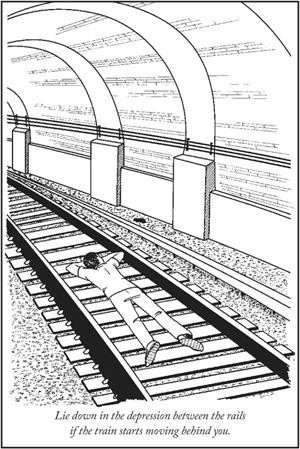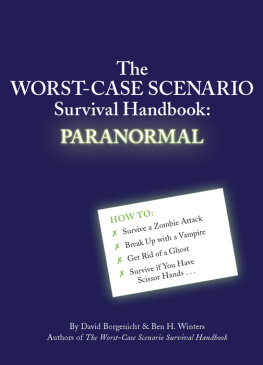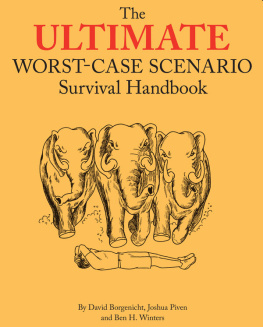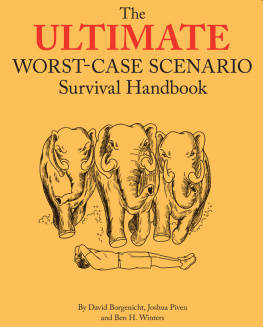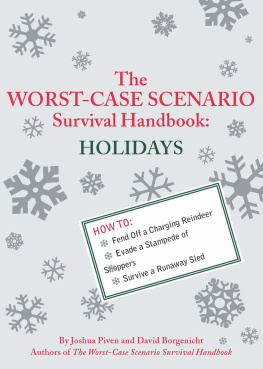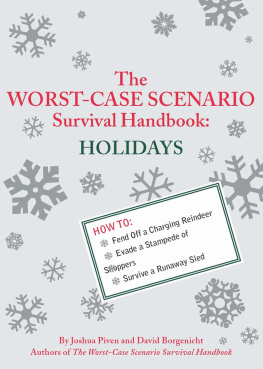The
WORST-CASE SCENARIO POCKET GUIDE
NEW YORK CITY
By David Borgenicht & Ben H. Winters
Illustrations by Brenda Brown
New York has always been going to hell but somehow it never gets there.
Robert Persig
Theres no place in the world thats quite like New York City.
Whatever you want, whatever youre looking to do, New York has it. Whether you want world class cuisine or the worlds greatest hot dog, to see masterpieces of art or masterworks of graffiti, to stare at celebrities or the craziest person youve ever seen, you can find them all in the Big Apple.
But its not a town for the faint of heart, for the panic stricken, for the weak-kneed, or the weak-bladdered. New York can be a cruel and unforgiving place, if you dont know how to survive it. The morning commute alone could be your downfall. Or crossing a street. But staying in your room isnt the answer eithercockroach infestations are everywhere. Theres a reason that the song says, IF you can make it there you can make it anywhere. The IF is keymaking it in New York is by no means guaranteed. Just making it uptown isnt even guaranteed.
Thats where this handy little guide comes in. Like its larger Worst-Case Scenario Survival handbook predecessors, The Worst-Case Scenario Pocket Guide: New York City provides you with the clear, step-by-step answers you need to survive The Citys inevitable and unexpected turns for the worse. In addition, youll find useful charts, lists, and instant visual solutions to help you navigate and survive The Citys perils.
Whether youre a first time visitor to New York or a seasoned Manhattanite, dont be caught unprepared. Youll definitely find something in this pocket guide that will help you survive New York. At the very least, its a great place to hide your credit cards.
The Authors
CHAPTER 1
GETTING AROUND
TAKING THE A TRAIN
HOW TO SWIM ACROSS THE EAST RIVER
1 Strip naked.
Leave on only a belt.
2 Put your clothes in a garbage bag.
Tie the bag closed so air remains. Using eight feet of thick, waterproof rope, tie the garbage bag to your belt. Leave six feet of slack rope between the bag and the belt.
3 Jump into the river.
Holding the bag and slack rope in one hand, run and jump feet first into the river.
4 Swim in a straight line.
Swim the crawl stroke, alternating 50 arm strokes with eyes closed and head submerged with four strokes swimming with your head above water. Locate the nearest bridge and use it as a reference point. Each time you bring your head up, refer to the bridge to ensure you are moving in a straight line. Scan the horizon in either direction for waterborne obstacles.
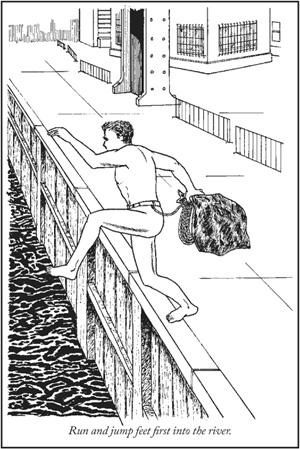
5 Use the garbage bag as a flotation device.
To restore your strength, cling to the bag with both hands. Hold your head above the surface and tread water until your arm strength returns sufficiently to continue swimming.
6 Emerge from the water in Brooklyn.
If you have emerged in Queens, get back in the water.
7 Untie the garbage bag from your waist.
Put your clothes back on.
8 Take a shower or bath.
Bathe in clean, fresh water as soon as possible to remove any sediment and pollutants from your skins surface.
Be Aware
There are relatively few points on the Manhattan side of the East River where it is possible to dive directly into the water. Before diving, look down; if you see FDR Drive, find another embarkation point.
The water in the East River is generally clean, though full submersion is not recommended by city authorities. Do not drink the water.
The ideal time for river swimming is approximately 7:40 A.M., when the river is at high tide.
Avoid potential hazards including ferry traffic, power boats, empty bottles, oil drums, discarded fishing line, nets, hypodermic needles, and corpses.
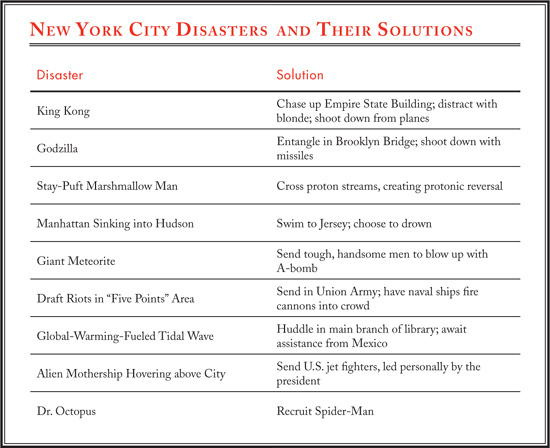
1 Stand upstream from other taxi seekers.
Position yourself so a cab coming down the street sees you first.
2 Step to the curb.
3 Lean forward with your arm extended at or above shoulder height.
4 Check both directions.
Turn your head rapidly from left to right to watch for a cab and to guard against someone moving in on your territory.
5 Protect your position.
Stare at anyone who approaches. Squint your eyes and shake your head aggressively, while continuing to wave your arm at the street.
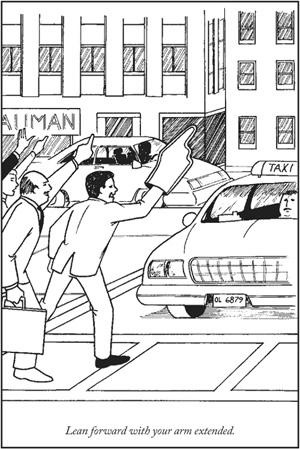
6 Signal for all cabs.
Do not limit yourself to cabs with lit domes. An occupied cab may be dropping someone off; an off-duty taxi may just be screening potential passengers.
7 Lock in the cab.
Once a driver sees you, nod at him, sealing the contract. Maintain eye contact with the driver and slowly lower your arm from its hailing position.
8 Signal the direction you want to go.
Indicate a U-turn, a turn at the far corner, or that the cab should pull up exactly to the place you are standing.
9 Enter the cab.
Be Aware
It is illegal for a taxicab driver to ask where youre going before accepting you as a rider, and it is your right not to answer until you are in the taxi and it has pulled away from the curb. A New York City taxi must take you to your requested destination within New York City, Westchester County, Nassau County, or Newark Airport.
Off-duty cabs, car services, and gypsy cabs may pull over in response to your cab-hailing gesture; it is not illegal to ride in a gypsy cab, but you will likely pay more than you would in a licensed city cab.
The standard tip on a taxi ride is 15 percent.
SIGNS ITS TIME TO LEAVE A TAXI
Taxi stuck in traffic, being passed by strollers, pedi-cabs, pedestrians
Taxi going 50+ miles above speed limit, up on two wheels
Taxi being pursued by police or National Guard
Driver asking you for directions
Strong odor
Taxi filling with smoke, flames
Banging, cries for help coming from trunk
Driver texting
Driver vomiting
Driver drinking out of paper bag
Driver sobbing, expressing loss of will to carry on
HOW TO ESCAPE A STALLED SUBWAY CAR
1 Alert the authorities of the situation.
Locate the two-way radios at the front of all train cars. Depress the button. Wait for the green light to come on, and speak. Release the button to listen.
2 Move forward to the next car.
Walk to the front of the train (in the direction that the train had been traveling) if the danger is in your car. Grasp the handle of the door at the front of the car and pull it to the right to unhitch. Slide the door open and step carefully over the coupling between cars to the door of the next car. If you cannot see in the darkness of the tunnel, use a cell phone or other mobile device to cast illumination on the tracks.
